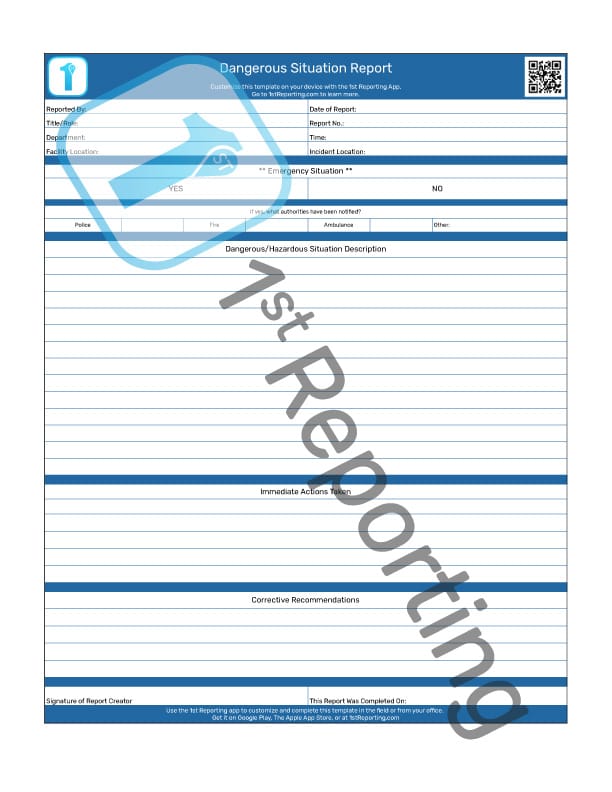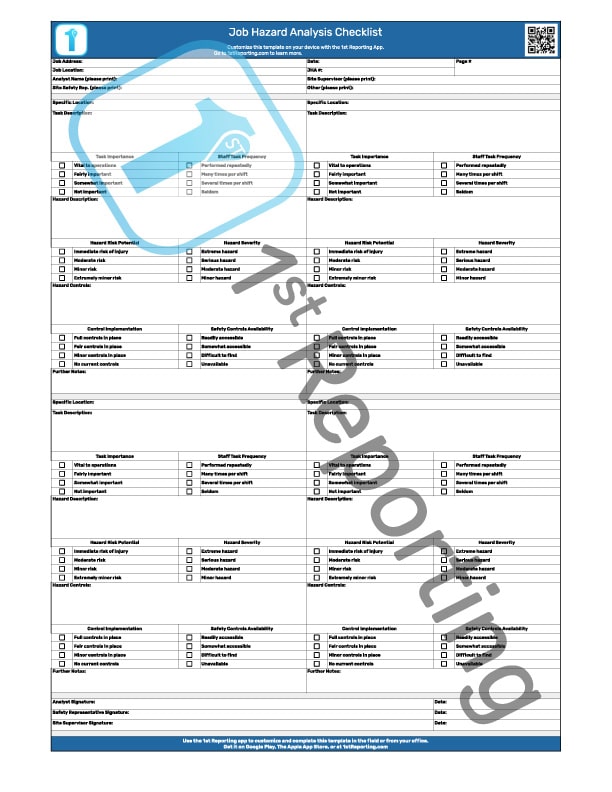
Welcome to your comprehensive guide on workplace safety and incident reporting. Today, we’re sharing a free Dangerous Situation Report Form to elevate your health and safety program.
Most workplaces have threats to safety in the form of dangers that can be obvious or worse, unknown. Staff need to actively participate in mitigating these situations on a daily basis. Whether you work in security, healthcare, manufacturing, or another industry, all workplaces have their share of dangerous situations.
These dangerous situations need reporting, and evasive action is necessary to avoid incidents. Utilizing a dangerous situation report form like the one we have for you here is an excellent way to handle these situations.
A Dangerous Situation Report Form (such as the one we have for you to download) is a form used to detail a situation where an incident is possible or even likely. The incident is typically one that could result in injury or damage to people or property. The report intends to document and correct dangerous situations.
Whether your business needs a printable form such as the one you can get later in this article or a digital solution (we’ll talk more about that later), the importance of acknowledging and documenting dangerous situations becomes quite apparent. Let’s look at what is included in the dangerous situation report and some of the best practices that go along with this type of incident reporting.
Included In The Dangerous Situation Report Form
The 6 Sections Of The Report
The different sections of the dangerous situation report are relatively self-explanatory. The sections are:
- Administrative Information – The name, date, location information of the reporter, and incident.
- Emergency Information – The dangerous situations may pose emergency services worthy threats. And if so, emergency personnel might be notified. This section provides a snap-shot view of said emergency service(s) contacted.
- Situation Description – The description is a detailed account of the dangerous situation, including external factors leading to discovering the danger or hazard.
- Immediate Actions Taken – Self-explanatory. It may include further details of emergency personnel notified of the event.
- Further Recommendations – If additional measures beyond the immediate are required to rectify the danger, this section is reserved for their notation.
- Report Sign-Off – An area where the reporter identifies that they are completing the report (to the best of their ability)
Each section of the hazard report is essential to the overall report’s success. With the purpose of communication and documenting hazardous, or rather, dangerous situations, each section needs completion clearly and concisely.
The greater the depth and accuracy of the information provided within each section of the report, the more the report will provide you with the information needed for a successful reporting process. It is why training staff to fill and file the report appropriately is essential to your H & S program success.
How To Use The Dangerous Situation Report
A few simple steps are all that is needed to use the Dangerous Situation Report properly. It is important to have an organized system for use of this type of incident report, such as the steps shown below.
- Download and print the Dangerous Situation Report Form.
- Provide copies of the Dangerous Situation Report form to your company safety representative (and other appropriate personnel).
- Train your staff to note any incidents that are deemed dangerous, according to your health and safety policy.
- Receive completed situation reports and apply the necessary preventive measures and actions.
- File your Dangerous Situation form for future analysis and mark a follow up date on your calendar.
Including a follow-up procedure to follow the submission of any dangerous situation report is another essential step in accurate incident reporting. It is especially vital in the situation where an employee or visitor is injured. Or even when dealing with an employee or visitor screening practices, it is wise to follow up when there is an irregularity in screening, such as a possible exposure scenario.
6 Steps To Dangerous Situation Reporting
How to Identify and Assess Workplace Dangers
With a process and procedure in mind, the following is a sample process used for dangerous situation reporting.
- Identify and Assess the Danger – Begin your reporting process by identifying the danger and assessing its severity. If immediate danger exists, don’t hesitate—call emergency services. The reporter determines the severity and whether or not to immediately dispatch emergency personnel.
- Remove Individuals From Potential Harm – Upon identifying a risk, any individuals within the vicinity should remove themselves (or be escorted) from harm’s way.
- Communicate the Risk – As any individuals find themselves escorted to a minimum safe distance, the risk needs communication. The communication process includes warding off an area, perhaps with warning signs, caution tape, pylons or other appropriate protective equipment, warnings, and guarding equipment.
Communication must also include notifying emergency personnel (if required) and any client or management who are in a position to be notified of said incident or occurrence.
- Control the Risk – If possible, the risk should be isolated if able to do so safely. For example, equipment might require locking out or even isolated behind safety barriers. The point is to do one’s due diligence to attempt to prevent any possible injury.
- Report And Assess – When the risk is controlled as best as possible, the reporter may complete the report form. At this time, the risk might face further assessment for further recommended actions. These recommendations should be detailed and included in the report.
- Follow Up and Resolve – Finally, after the report completion occurs, a company ought to follow up with either a permanent resolution or some other plan to remove the danger in a long-term capacity.
As you can well imagine, a dangerous situation may quickly escalate into an injury or worse. Time is of the essence when dealing with hazards or dangers that pose a threat. Using a dangerous situation report to track these incidents is vital to a successfully implemented health and safety program. However, the speed that a handwritten report completion occurs is no match for a digital reporting solution’s reporting ferocity. A digital solution can achieve in seconds what a manually handwritten report can do in potentially hours. But, we’ll get more into a digital solution later. First, let’s talk a little about how this report and processes can add value to your risk assessment and reporting practices.
Adding Value To Your Hazard Risk Assessment
The essential element of any preventive program is removing possible dangers to people, equipment, or property through preventative action. The actions deemed necessary for said preventive measures will depend upon the particular situation, industry, and occurrence. But how do we add value to a reporting system that is meant to eliminate risk and has little to do with increasing profits?
The real value of the dangerous situation report and other pre-emptive health and safety reporting practices is eliminating potential health, life, or financial losses levied by an accident or incident.
By reducing risk exposure, a business reduces its potential losses at the hands of an incident or accident. And although these potential losses are not realized until an incident occurs, as a part of disaster mitigation, the reduction of risk exposure is critical to ensuring that the returns gained from business activities are not overshadowed by loss due to incident occurrences.
Including minor or even seemingly trivial details about a situation may help understand how the risks may find appropriate mitigation and face a controlled prevention action and elimination.
Adding value to a report by including supplemental media such as photos, audio, or video files is an excellent way to increase the dangerous situation reporting procedure’s value. However, with a printed handwritten report, these supplemental media files’ inclusion becomes more than just a challenge. It’s for this reason that if your business is serious about your reporting processes, a digital solution like the 1ST Incident Reporting App is perhaps a much better solution to fulfill your reporting needs.
Speaking about adding value to your reporting process, let’s dive into a few tips to ensure your dangerous situation reporting process is on point.
Hazardous And Dangerous Risk Reporting Tips
Understanding the difference between dangerous and hazardous situations becomes vital in measuring the appropriateness of filing a dangerous situation report versus simply filing a Safety Leading Indicator form.
Whether your industry is security, construction, logistics, healthcare, or any number of other industries, if there is a physical place of business, there can be a potential for a dangerous situation.
- Tip 1: Create a robust health and safety program that encourages good reporting practices helps businesses stay clear of costly and frightening dangerous situations where people or property might suffer the consequences if ignored.
Here are a few essential tips to help your business streamline the dangerous situation reporting process. The following are three critical policy tips recommended to implement into your hazard situation reporting program.
- Tip 2: If immediate bodily injury might occur, remove yourself from harm’s reach and cordon off the area.
- Tip 3:Communicate the hazard to anyone working in the area.
- Tip 4: Immediately contact management and advise of the risk.
What’s the takeaway here?
- Tip 5: Include appropriate training for all staff regarding safe work practices.
As mentioned earlier, a digital reporting solution could help mitigate these dangerous occurrences from happening. How is this possible? Because if a hazard was identified and a report generated and submitted, the near-instantaneous report submission would not be lost in a shuffle of paperwork but likely addressed instead. Let’s talk a little more about how a digital solution might be the best option for your business.
A Digital Dangerous Situation Form Solution
Printed Dangerous Situation Report forms are a great idea when no other system is in place or available. However, what if you could take things to the next level of technological efficiency? What if you could eliminate the physical report and exchange it for a digital solution? At 1st Incident Reporting, it’s not an idea; it’s a way of life. Here are a few of the benefits of going digital for your dangerous situation reports (and other reporting, for that matter).
- Increased Efficiency
All processes take time within a business ecosystem. Reducing costs for procedures and processes is essential for efficient operations. A digital solution to manually handwriting reports saves your business time and, therefore, money.
- Additional Media Coverage
If adding photos, video, or even audio files and more directly to the report is essential to you, then a digital solution is the best option.
- Instant Notifications
When a dangerous situation arises, having instant notification is vital to navigating the event successfully. In emergencies especially, instant notifications allow you to spring into action without delay.
Want to try a digital solution for dangerous situation reporting?
Click Here to test out the 1st Incident Reporting app.
Sources
- https://www.sciencedirect.com/topics/computer-science/hazardous-situation
- https://dictionary.cambridge.org/us/example/english/dangerous-situation
- https://www.researchgate.net/post/How-to-calculate-Risk-by-integrating-Hazard-and-Vulnerability#:~:text=The%20Risk%20equation%20is%20known,%2B%20Vulnerability%2C%20with%20no%20justification
- https://www.osha.gov/data/commonstats
In a world where risks and hazards are an undeniable part of the workplace, understanding how to effectively report and mitigate these dangerous situations is not just good practice—it’s a necessity. Our guide arms you with the information and tools to elevate your Dangerous Situation Reporting to the next level. From understanding the 6 vital sections of a report form to implementing actionable steps, we’ve got you covered.
Now is the time to act. Don’t just read this and move on; take the plunge into adopting a robust health and safety program. Upgrade to a digital reporting solution today and redefine the way you approach workplace safety. Protecting your team and assets begins with a single step: adopting a reporting system that works. Make that step now!





